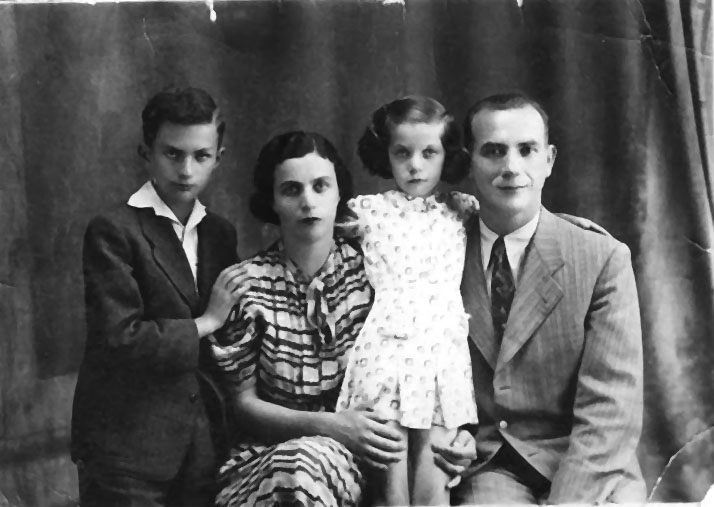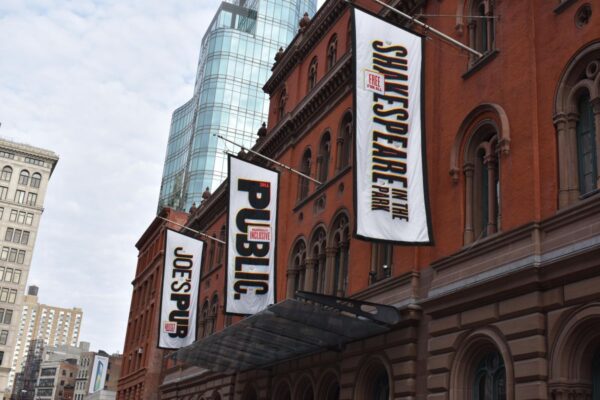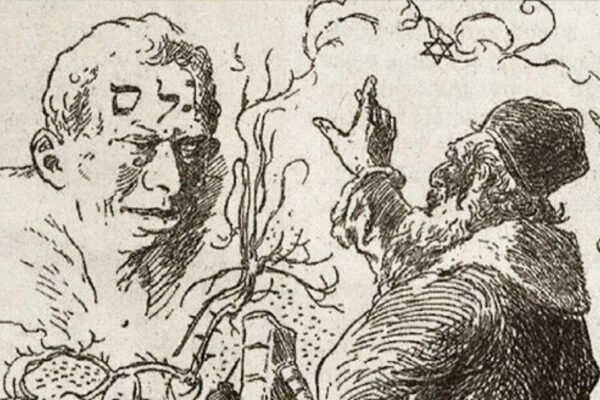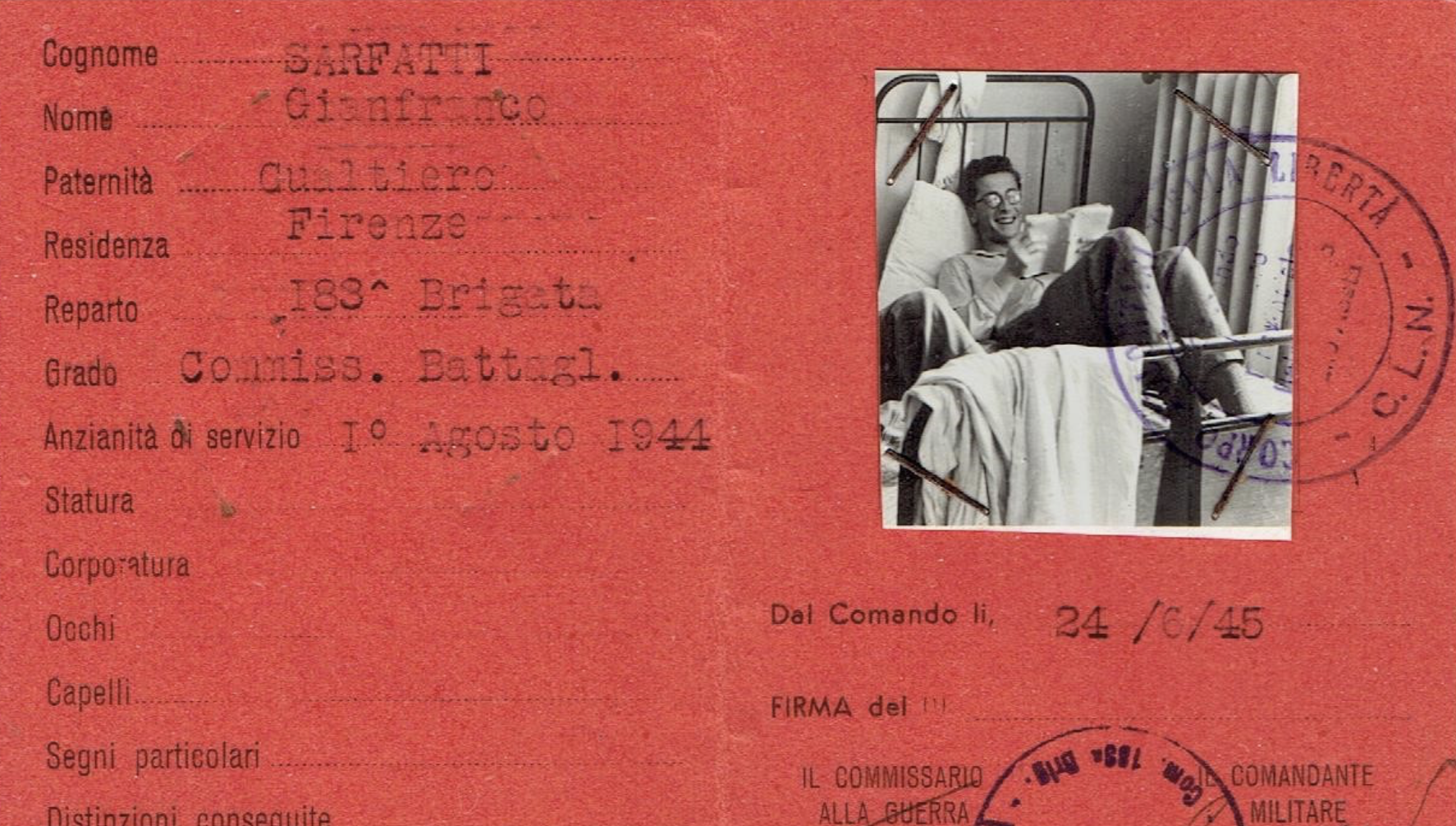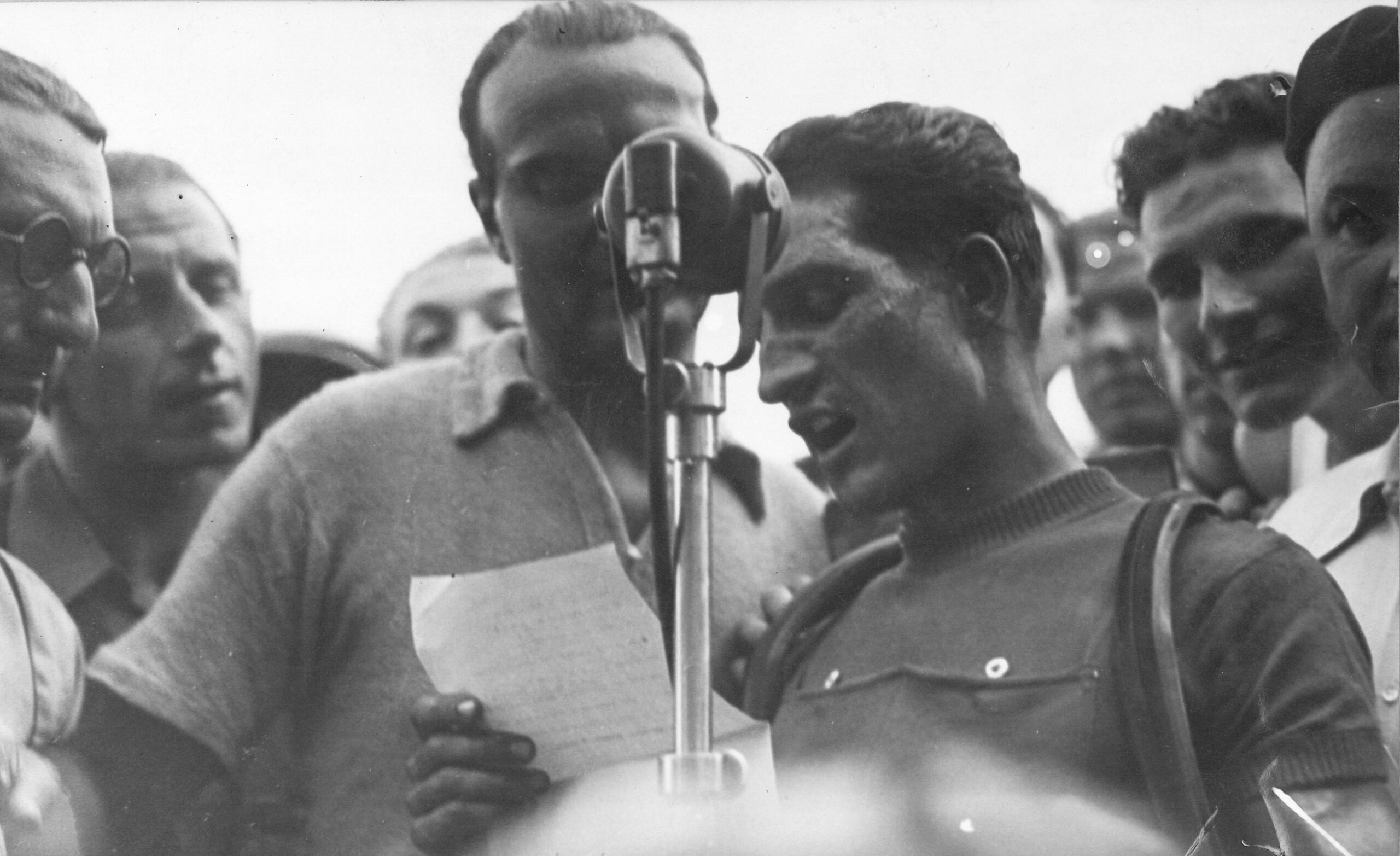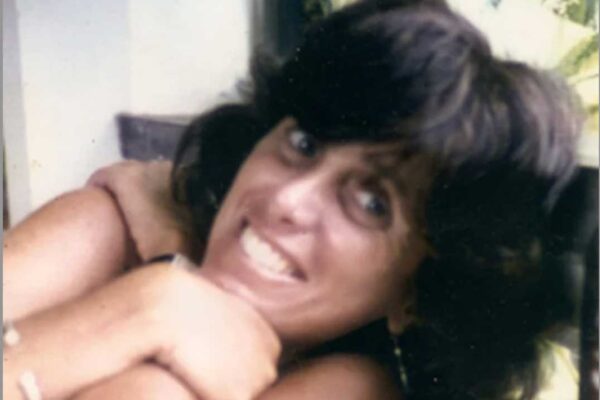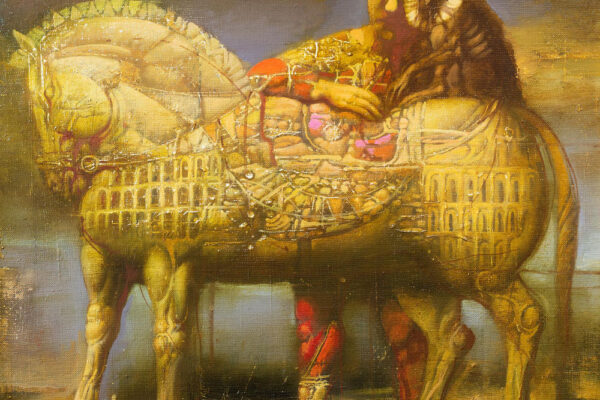From Sarajevo to Parma, a Jewish family during the Second World War
In the days that preceded Christmas 1941, before the eyes of the stunned inhabitants of the community of Gramignazzo di Sissa, agricultural center of the Bassa Parmense region on the delta of the Taro River, which counted a few hundred residents, an unusual scene unfolded.
At the entrance of the village’s inn, a bunch of men crowded around, who, having hung their capes for the day, were smoking and energetically playing cards, when from the coach arriving from Parma descended a large group of civilians loaded with suitcases and children. Dressed in their city clothes, they looked around, disoriented, searching for someone to welcome them or tell them where to go, where to sleep, where to put down their belongings.
They were Kalmi Musafija (1873) and his wife Rifka Montiljo (1874) with their numerous sons, daughters and relatives: Jacob (1895), Regina (1900), Lenka (1904), and Haim (1905). Regina was with her husband Alberto Finzi (1894) and their two children Kalmi (1927) and Moise (1923); Lenka was with her husband Josef Finci (1895) and their two children Asher (1929) and Erna (1934). In all they were twelve people. Another eight people from the large family had stopped in Sissa, a few kilometers away.
The first nights the Musafijas/Fincis/Finzis slept at the inn, it was very cold. The day after they arrived, the owner procured bed-warmers for them, colloquially called “priests,” about which the family would speak ironically but good-naturedly for a long time.
A family from the village was willing to rent rooms to Yugoslavians—the Pagliaris, landowners who already rented a large part of their own house to their tenant farmers, the Ponghellinis. The Ponghellini family, who was decisive in ensuring the Fincis’ serenity and well-being, was composed of Telesforo, his wife Emma, their son Enzo with his wife Esterina Poletti and little Nino.
The Pizzi family did the same; Rolando, a landowner, and Giovanni, the owner of the local brick factory, without becoming in the least bit perturbed about having contact with Jews despite the elevated positions they held in the Fascist party. In fact, Giovanni was Magistrate of Sissa, while Rolando was one of the founders of the local chapter of the Fascist party. Rolando offered to rent some rooms in his farmhouse with the full agreement of his brother Giovanni.
The rest of the family, Alberto Finzi’s sister Zimbula (1905), her husband Isidoro Papo (1892), their children Haim (1924) and Rena (1930), settled into nearby Sissa; just as another one of Isidoro’s brothers, Abramo Papo (1888), with his wife Zafira (1892) and their two sons, Jacob (1913) and Josef (1923).
But where were these foreigners from? They came from far away. Their country was Yugoslavia, their birth city Sarajevo, the charming capital of Bosnia Herzegovina, elevated 500 meters above sea level, lively and tranquil crossroads of Islamic and Greek Orthodox culture, which also counted a minority of approximately 8,000 Jewish citizens, who were very much assimilated into the area’s cultural and social life.
The elder Kalmi Musafija imported coffee and had continual contact with the merchants of Trieste. The daughter Lenka’s family, the Fincis, whose relatives were observant Jews (Josef’s father was a rabbi), owned the largest stationary and bookstore in the city center. The family of the other daughter Regina, the Finzis, were shirt-sellers. They were people of a certain education and status, who enjoyed the esteem and consideration of the city’s bourgeoisie. The language they used at home was Serbo-Croatian, but they also spoke Ladino, a Spanish dialect infused with Hebrew words, spoken by many Mediterranean Jews. In 1939, part of the family had immigrated to Palestine to fulfill a Zionist ideal that was rather diffused in the Jewish community of Sarajevo.
The horizons were darkening with the winds of war brought by Hitler and Mussolini. On April 6, 1941, the Italian and German armies simultaneously attacked Yugoslavia. The victors dictated the conditions of surrender on April 17, 1941 and the Yugoslavian territory was declared occupied. According to a bilateral agreement with the adjoining nations, it was decided that the territory would be divided between Hungary, Bulgaria, the Reich, Italy and Albania.
Italy annexed southern Slovenia and the Dalmatian coast, while the western part of Montenegro, western Macedonia and northwestern Greece were annexed to Albania, thus putting Greater Albania under Italian protection.
What was left of the old territory was transformed into a new national entity called the Independent State of Croatia, with a capital of Zagreb and the leader Ante Pavelic, founder of the Ustaše (literally: rebel) movement, allied until 1929 with the Italian Fascist government, which always bankrolled and pandered to it in the hope of recompense, either in land or in the extension of a zone of influence (compensation that Italy would effectively obtain). At the end of March 1941, after years of exile protected by the police in Italy, Ante Pavelic, from his general area of Pistoia, called back his Ustašes. It was the nucleus formed by 500 men from his militia, dressed in old Italian colonial uniforms with the military insignias and symbols substituted. Pavelic’s politics were hatred of a multiethnic Yugoslavia and intolerance toward the presence of Serbs, Jews, and gypsies in his territory.
It’s been calculated that between locals and refugees, there were approximately 35,000 Jews who remained trapped in the new state, most of them located in Zagreb (12,000 Jews). They fell at the mercy of rabid anti-Semitism, rape, violence against women, abuse in concentration camps, and since mid-April, governmental anti-Serbian and anti-Semitic ordinances. On April 30, 1941, the racial laws were decreed.
In a state of panic, the Jews tried at all costs to leave their homes, paying exorbitant sums to the local officials in order to obtain false identity papers. The only way to travel by train in order to reach the Italian territories was to pass for a non-Jew. The Italian annexed territories became a mirage they attempted to reach in order to escape from the Ustaše.
With the decree of May 19, 1941, the three newly annexed Italian territories, distinct and far from each other, were administered in the following way: the coastal area southeast of Fiume with the cities of Susak and Bakar were administratively absorbed by the Province of Fiume, with the local Prefect as its chief; the southern half of Slovenia with the city of Lubliana was administered by a High Commission; the Dalmatian coast between Split (Spalato) and Zara with the coastal islands and the surroundings of Kotor (Cattaro) were administered by the Governor of Dalmatia Giuseppe Bastianini, for a year and a half, starting in mid-June 1941.
It’s been calculated that approximately 6,500-6,600 Jews managed to escape to the Italian territories between the division of Yugoslavia (at the end of April 1941) and the Armistice (September 8, 1943). Of these, about a thousand were sent back at the border, while the others were for the most part transferred to internment in true Italian territory (the camp of Ferramonti di Tarsia, and various free internment camps) or in the area of the Dalmatian coast. The hardest borders to access between the three were without a doubt those of the Province of Fiume, whose prefect Temistocle Testa mercilessly sent people away.
Later in Croatia, beginning in July 1942, the Jews found themselves in danger not only because of Ustaše military violence, but also because at that time the politics of the extermination of European Jews by the Germans would ultimately be organized in an agreement between the Croatian and German governments, who would carry out their plan together. According to this agreement, Jews who were arrested had to be taken to the German police to be deported to the eastern territories (a euphemism meaning the Auschwitz concentration camp), their belongings confiscated by the Croatian government, while the government would give the Germans thirty marks for each deported Jew.
Those who managed to pass the Italian-German border and presented themselves to the Italian authorities were subjected to two different types of measures: a) be sent back and handed over to the Ustaše, b) having reached the Italian territory, be put into designated local internment camps under military surveillance, or be “deported” to actual Italian territory to be interned.
The Jews nevertheless particularly appreciated this last measure, which was actually a police measure. Compared to Croatia, Italy seemed like a safe haven. For another two years, there was neither a German occupation nor anti-Semitic persecution on the horizon that threatened their lives.
During the bombing of Sarajevo, Josef Finci’s apartment in via Cemerlina was damaged, so the family moved in with his wife’s parents, Kalmi and Rifka Musafija, into a building in the city center. It was a big apartment and the Musafijas were forced to cede part of it to a Wehrmacht official and his attendant. This burden later became a blessing because it was probably one of the latter who warned the family in mid-May 1941 that all Jews were in danger and they had better leave Yugoslavia.
An orthodox Serbian friend, director of the Yugoslavian railroad, informed the Fincis that they should go to Montenegro, which was occupied by Italian troops, and was able to accompany them. The whole large patriarchal family, consisting of twenty members, left by train toward the southeast, carrying false papers with Muslim names. There were the patriarch, with his direct and indirect descendants and relatives and the spouses of his children. Kalmi’s other daughter, Lotte Musafija (1909), with her husband Max Najman (1898) and their son Roberto (1939), lived in Belgrade and later joined the rest of the family at Split.
At Cetinje, the former Royal capital of Montenegro, they gave themselves up to the Italian army and for several months lived in peace in a rented house. Not long after, in July 1941, began the uprising of Montenegro’s population against the Italians. There was an attack by members of the local resistance and the subsequent repression. During a roundup, among those from the civilian population, some of the men from the Musafija/Finci/Finzi/Papo family fell into the trap. The women went to visit their relatives and little Erna Finci remembers that she burst into tears upon seeing her loved ones imprisoned. Soon after, the Italian authorities recognized that the Jews had nothing to do with the Montenegrins’ revolt and let them go.
After this episode, the large family decided to leave Cetinje immediately and move to Split on the Adriatic coast, in annexed territory, assimilated into Italy proper.
The Italian authorities decided to intern them in Italy with the status of “civilian prisoners of war.” The internment conformed to Bastianini’s idea of not having to worry about a mass of refugees that he couldn’t keep watch over and that were inconveniently stationed temporarily on his territory. Even the Union of the Israeli Italian Community intervened with the authorities so that the refugees would have some assistance and be reunited in a protected place.
It was a matter of time; the Italian authorities interned a few thousand refugees in Italy, but later adopted a policy of rejecting them at the Italian-Croatian border.
Luckily the Fincis/Finzis/Papos/Musafijas/Najmans made the move at the right time and thus were part of the contingent of the few thousand people who were allowed to enter Italy to be interned in small centers in the north, in the provinces of Aosta, Asti, Treviso, Vicenza and Parma.
So the large family was loaded onto the Kotor ship together with other refugees, without knowing where they were going, and after a few days on the Adriatic Sea, they were made to disembark at Trieste.
There were two immediate destinations: San Vincenzo della Fonte in the Aosta Valley (the three Najmans, who on October 5, 1943 were transferred to the Ferramonti camp in the province of Cosenza, then later to Gramignazzo, to reunite with their family); the others were sent to various places in the province of Parma. There were additional later transfers and all, or almost all, the members of the big family later ended up interned at Sissa or nearby.
The Yugoslavian refugees from Sarajevo sent to the province of Parma constituted a contingent of 212 people, according to the telegram that the Ministry of Internal Affairs sent on December 11, 1941 to the prefect of Trieste and copied to the governor of Dalmatia and Zara and to the prefects of Kotor, Split and Parma. The new arrivals were divided between the towns of Roccabianca, Sorbolo, Bardi, Bedonia, Traversetolo, Zibello, Langhirano, Sissa, Soragna, Tizzano Val di Parma, Tornolo, Mezzani, Calestano and Borgo Val di Taro.
But what exactly did internment mean in 1941? It was a status of semi-surveillance in small towns, far from the big cities and the confines of the Italian territory, where the civilians could plant crops, as long as they stayed out of the way, didn’t mix with the population, didn’t work, didn’t go beyond the prescribed perimeters, didn’t own a radio, didn’t read foreign newspapers, didn’t host unauthorized families, didn’t carry passports and other personal documents, deposited into a restricted account any amounts exceeding 100 Lira, and signed a roster three times a day at the appropriate registry at the town hall. They were allowed to write letters to family members interned in other places.
Each interned person chose an accommodation, indicated by the local authority and, in case of need, received a small sum to sustain him (8 Lira for the head of the family, 4 Lira for other members, plus a monthly rent subsidy of 50 Lira.)
Many Yugoslavian Jews interned in Italy ended up under this regime, swelling the already large number of foreign Jewish refugees who had fled from Nazi anti-Semitism and Hitler’s advancing army in all of Europe. These people, who were stateless or citizens of a nation propagating anti-Semitic politics with harsh police measures, had been torn from the temporary houses where they were waiting for an entry visa to other countries, chained like criminals, locked away in prisons of the principal cities and interned in the camps like Ferramonti di Tarsia (Cosenza) or Campagna (Salerno) or Civitella del Tronto (Teramo) or others, without sufficient room, even in small mountain or rural centers.
Their situation was painful because of the family separations, the extreme harshness of the living conditions of the local farmers among whom they ended up, when exiled in remote villages, and the intellectual and social starvation to which they were restricted. The internment measures for these foreign Jews operated from May 1940 until after Italy entered into the war.
In total, there were 374 foreign Jews (all foreign Jews, not only Yugoslavians) interned in the province of Parma between June 1940 and September 8, 1943, distributed in various small centers: Bardi, Bedonia, Berceto, Borgotaro, Calestano, Langhirano, Medesano, Mezzani, Montechiarugolo, Minticelli Terme, Roccabianca, Roccalbegna, San Secondo Parmense, Scipione di Salsomaggiore, Sissa (and Graminazzo di Sissa), Soragna, Sorbolo, Tizzano Val Parma, Tornolo, Traversetolo, and Zibello.
After September 8, 1943 and the beginning of the German occupation and the alliance with the Italian Social Republic, 36 of the 212 Yugoslavs from Sarajevo interned in the province of Parma were arrested and deported.
The places of their arrest are: Bedonia, Calestano, Mezzani, Tizzano, and Traversetolo. The perpetrators of the arrests were all Italians, probably policemen who, since the first light of dawn of December 1, 1943, after the order of detention by the Italian Social Republic, began to go into the places of residence forced onto the foreign Jews and the homes of Italian Jews to apprehend them. It can be deduced that, in the above-named centers, the local police acted more zealously than in other cases and rounded up the free interned people who were unprepared, but one of the reasons why those interned in other villages escaped was, without a doubt, the readiness of spirit that made them run away from their place of residence quickly and in hiding.
A few Yugoslavs from Sarajevo interned in the region of Parma were arrested even after running away from their forced residence or later, on their escape route, like for example the Israel family (Flora, Jesua and their son Moshe) interned at Langhirano, then arrested at Lanzo d’Invelvi while en route to Switzerland; imprisoned in Como, they were sent back to the prison in Parma where they were originally kept, as that was the norm. Of the people whose story we’re following, Jacob Musafija, little Erna and Asher Finci’s uncle, along with his brother Haim, also chose to go south rather than toward the north and Switzerland, like the rest of the family. We learn from Marco Minardi’s book the sad story of Jacob, while Haim’s case is made up of a series of lucky coincidences that brought him to safety. The two of them left Gramignazzo di Sissa for Parma. They presented themselves to the registry declaring themselves displaced persons from Bari and wanting to stay temporarily in the city despite having lost their identity papers. They were lucky because the clerk accepted their declaration of displacement, as the city police inspector would later declare in an attempt to justify the error committed because of an “enormous crowd of people in that period in the displaced persons section of the registry in consequence of noted politico-military events.” The following day, the two brothers presented themselves to the office of the urban police with files given to them by the registry in order to request identity cards, which were granted because of the big confusion that reigned in the office. Their new names were Vittorio and Alfredo Politi. Fortified with their new papers, they headed toward Florence where unfortunately they were discovered and arrested at the beginning of December 1943 and imprisoned at Murate. From there they were sent back to the province of Parma, from whence they were trying to escape. Haim fell ill and was hospitalized at the main hospital in Parma, and escaped thanks to a member of the local resistance, a heroic nurse named Maria, whose last name is unknown. Maria remembered Finzi’s parents, and got them to give her clothes to bring to the hospital. Dressed in normal clothes, Haim made it out of the main door and into the street where Maria’s child was waiting to take him arm in arm and bring him to safety.
Jacob, on the other hand, had no choice but to follow the sad lot of the Jews arrested in the region of Parma. Locked up in Scipio’s castle, he was sent to the Fossoli camp and on April 5, 1944 deported to Auschwitz, where he disappeared.
As for the rest, all of the Jews, Italian or foreign, arrested in Parma and the environs followed the same path: imprisoned at Monticelli, the women in the Thermal Baths hotel, the men in the former castle of Scipio of Salsomaggiore, and taken from there to the Fossoli di Carpi Police and Transit camp to be sent by train to the extermination camp of Auschwitz in Upper Silesia.
But all of that came after Italy signed the armistice with the Anglo-Americans and attempted to extricate itself from the grasp of Nazi Germany (September 1943).
Going back to the Fincis/Finzis/Musafijas who disembarked at the end of 1941 at Gramignazzo and Sissa. They attracted a lot of attention, but were immediately treated well by the local villagers, with whom they shared goods, food, ideas and cozy evenings spent together.
No one wished to isolate these people who came from far away and spoke various languages: German, French, Hungarian, in addition to Serbo-Croatian and Ladino, as we’ve already said.
On average the teenagers received more instruction in those places and quickly learned Italian. Moise Finci taught stenography to his neighbor Ezio Bosi, and they took long bike rides along the riverbank and swam together. The kids played with the neighbors’ children. The oldest studied the books received from the Organization of Jewish aid DELASEM (Delegation of Assistance to Jewish Immigrants). The adults were more reserved and mostly stuck with the family, passing the time by playing cards amongst themselves. The restrictions also said they couldn’t get mail or leave the country, and the children couldn’t go to the local school.
Despite the rules, during the summer, the Finzi, Finci and Papo kids got together to swim in the Po River. They went to the nearby town of Torricella di Sissa, swam across the Po and finally got to the beautiful beach at Torricella del Pizzo (in the province of Cremona); there was a small farm where watermelons grew and they all stuffed themselves. The young Yugoslavs were good swimmers. Once, during these outings, a boy from Sissa (Enzo Calzolari) was in trouble and Moise Finzi saved him, earning the local families’ admiration and affection.
In 1942 Passover fell on April 3-8, and DELASEM gave all the interned Jews matzah, even though the rabbi of Parma, Enrico della Pergola (who was then tragically struck by the arrest and deportation of his wife and two young sons) wasn’t allowed to go to the internment camps for religious functions.
Josef Finci’s family brought their customs and extraordinary solidarity to their neighbors, the Ponghellinis. In particular, Erna affectionately remembers Esterina Poletti Ponghellini, wife and mother of the family of farmers who helped her mother around the house and with the kids.
The other important family, the Pizzis, invited the Fincis to lunch and musical evenings, while the Fascist magistrate of Sissa, Guerino Bianchini, was very respectful towards them. When he was driving his horse and carriage and ran into the grandfather, he said, “I can’t offer you a ride because of the racial laws, but I’ll get down and walk with you.” In their time of need, he was the one who allowed the family to obtain false papers and ration books.
Life went by calmly, but dealt a devastating blow on May 29, 1942 when the grandmother Rifka died in her sleep. They gave her a Jewish funeral, since they still could, and buried her in the cemetery of Parma.
After two years like this, all of a sudden the situation became dangerous once again for Jews due to the precipitation of political events. Rather than the Allied troops, in September 1943, the Germans occupied Italy and brought their extermination policies that were already in effect in the rest of Western Europe since the spring of 1942. Italian and foreign Jews who lived out in the open were forced into secrecy. Those who were in big cities tried to hide in the country or in convents. Foreigners like the Fincis, who had developed friendships with the locals, were helped to get false identity papers and move to safer locations. As Marco Mindari explained in his book The Invisibles, between the end of September and the first week of October, many Yugoslavian families tried to disappear in a sort of silent, massive “evasion.” The chief of the province of Parma, Antonio Valli, wrote to the minister of the interior on October 26, 1943, “on the occasion of recent events, many isolated interned people in this province’s towns have illegally run away toward an unknown destination.”
Even the Fincis, conscious of the danger that threatened them, left their home in Gramignazzo under the cover of darkness, counting on the help of their dear neighbor Esterina Poletti Ponghellini. Their first refuge was actually a supply shack in the middle of the vineyard that the Ponghellinis cultivated a few kilometers away from their home.
Hidden, Esterina brought them food and clothes every night, crossing the field on foot and risking her safety. But she wasn’t the only one to come to their aid. They had a notable network of support, and even Alfiero Azzali, the clerk at the registry in Sissa, went behind the magistrate’s back and gave them identity papers through his daughter Maria Teresa. Fausto Catelli, who preserved the memory of these events, wrote in 2005 (on the occasion of a visit from Erna Finci with her husband, the great scientist Andrew Viterbi) the book Not Only Deportation: The Holocaust Also Happened in Sissa. He published diverse testimonies on the events of the Yugoslavian Jews’ sojourn at Gramignazzo and an interview with Maria Teresa Azzali. She remembers it like this, “My father called me and gave me an envelope to bring to Gramignazzo. He put the envelope in my shirt… I didn’t know exactly what it contained, but I understood the instructions he gave me: ‘Go to Gramignazzo and give this envelope to the woman who’ll be waiting for you at the gate across from the bakery at the edge of town. Hurry, don’t stop to chat with anyone… act natural and go home as soon as you’ve delivered the envelope.’ I biked from Sissa to Gramignazzo… I delivered the precious envelope. On the way back, between Sissa and Borgonovo, I saw my father, who was anxiously coming to meet me, from afar. Since he had told me to act natural, I gave him a little wave signaling that everything went fine and we each returned home separately as if nothing had happened. My mother knew nothing about it.” These papers were filled in with the fake name Orsini, supposedly evacuated from Southern Italy, which was already liberated by the Allies. After a few days on the farmstead, the Yugoslavian Jews fortunately made it to Parma and were taken in by loyal friends of Rolando Pizzi and the magistrate of Sissa.
On September 23, 1943, the state police reported to the police headquarters that the Jews from Sarajevo had “mysteriously run away the night between the 15th and the 16th at an unspecified time for an unknown destination.” The magistrate, having participated in the “crime” denounced it, “for [my] duty to [this] office”. At that point, it was no longer prudent to stay together, so each nuclear family’s path went its separate way. I haven’t been able to follow all of their tracks, but I know that the four Fincis (Josef), passing for displaced persons, were hosted by the family of Vittorina Contini in Parma, at 68 Via Corso Corsi, (but they had all confirmed that there was something more, Asher said). The grandfather Kalmi and the Najmans lived with another family in Parma. The four Papos (Isidoro) were generously hosted at the home of Mario-Severino Alfieri, an oil merchant and owner of a distillery, in Via Ortles in Parma. They lived in fear of being discovered, so much so that Alfieri disconnected the doorbell because it terrorized them every time it rang. Since they needed money, Alfieri even found a buyer for the jewelry that the Papos had brought from Sarajevo just in case. He was a friend, a certain Mr. Mario Ugoletti.
With regard to this part of the story, Fausto Catelli kindly provided me with the following dramatic testimony from Alfieri’s daughter Anna Claudia.
“Having a big house, but especially ‘a big heart,’ my father, upon the request of some friends, dedicated himself to welcoming and ‘hiding’ Papo Isidoro and his family, since after September 8, 1943, with the military occupation of Nazi troops in Parma, their situation of ‘interned Jews at Sissa’ was easily discoverable and dangerous, because the treatment that the Nazis reserved for the Jews in their occupied territory was notorious: arrest and deportation. So Papo Isidoro with his wife Zimbula Finzi, his daughter Renci and his son Mico, whom I had already met at friends of the family’s house in Sissa, arrived… during that period, my father always met his old childhood friend from Langhirano, Giacomo Ferrari (partisan commander ‘Arta’) in Parma, who had returned to our city after a long absence first in France and then in Milan, where he participated in the anti-Fascist Resistance. The events determined by the announcement of the armistice with the Anglo-American forces with the consequent huge German invasion of Italian territory, had pushed him to return to his city to organize a partisan Resistance in the Apennines of Parma. Posing as a researcher looking for coalmines to exploit, he crossed the mountain regions and immediately began to organize the bases for partisan guerrilla tactics. Naturally his behavior couldn’t pass unobserved and so to evade surveillance, he was warmly welcomed in our house in via Ortles, which had become a refuge for persecuted people, and from there he continued his anti-Fascist activities. I was a young girl and I wasn’t aware of Giacomo Ferrari’s true activity; I knew that he was my father’s childhood friend and that was all. Only afterwards did I learn his true identity, he was an important agent of the Resistance with a battle name of Arta and the only commander for the region of West-Cisa. In 1944, we moved to Langhirano where we had an old family house. This decision was made because of the continuous bombing of the city and from the moment the news reached my father, he gave a heads-up that our house was already considered a ‘refuge for wanted people.’ So we lived in Langhirano when one day the lawyer Mazza advised my father to flee and join the partisans in the mountains because the Nazi-Fascists had learned about his collaboration with the partisans at Parma. September 8, 1944, my father left home and headed for the Apennines, but someone had found out about his plan and told the Nazi-Fascists, so for several days they were already keeping him under their surveillance, and since the quasi-necessary way to reach the partisans was through the town of ‘Carretti,’ they waited there for his arrival. Realizing he was being followed, he hid behind a bush in the town of Pilastrello, where he was discovered and gunned down with a bullet to the neck. He was only fifty-one years old. That’s how my father was killed. His crime was having believed in freedom and democracy and having welcomed Jews and partisans into his house in via Ortles in Parma in the most absolute discretion and for having collaborated silently in the Resistance.”
In Parma, the Fincis lived in complete secrecy, leaving the house very little and making the father Josef pretend to be a deaf-mute so his pronunciation wouldn’t betray them. However, the only hope of safety was Switzerland and their strength was aimed at organizing their escape to that country.
Isidoro Papo was the first to move with his family, who crossed the border on November 29, 1943; then Alberto Finzi went with his family, reaching Switzerland on the following December 6. Josef Finci and his family were delayed for a long time with part of the Najman family, managing to cross the border only on April 6, 1944.
The events are a bit vague. According to the testimony of Asher Finci, his father also got in touch with Mario-Severino Alfieri, so he would help them, as he had already done for the Papos. “Arta” himself, or someone else, went to get the Fincis in Parma, traveled with them to Milan and from Milan to Como, then put them on a boat and brought them to Moltrasio, on the western side of the lake. He left them there in a farmer’s house, and from there they left in small groups at ten o’clock at night to secretly cross the border. They had to climb the 1,315 meters-high Bisbino Mountain along unpaved paths and hike down into the Italian-Swiss part. The walk lasted hours. The slope wasn’t excessive, on average seven percent, so that all the members of the family managed to overcome it, despite their fatigue. Only the grandfather, Kalmi Musafija, was wheeled in a wagon because he was too old to use his strength.
First the family of Erna and Asher left with their uncle Haim, who had escaped from prison. From a distance they heard dogs howling and the guides explained that they were German dogs. The following week, the second group, composed of the Najmans and the grandfather, left. At the end of April 1944, the whole large family had surpassed the wire fence and found themselves safe and sound in Switzerland. The first town they encountered was Bruzella, then Balerna and Mendirisio. Only the uncle Jacob Musafija was missing.
Some doubts about the family of the other Papo, Abraham, subsisted. They didn’t go to Switzerland because there was no entry report for them, they didn’t appear in the Central Database of Holocaust Victims of Yad Vashem. On the other hand, the CDEC had never intercepted them in their search for Italy’s deported. According to the testimony of Asher Finci, they all would have disappeared, but with Anna Pizzuti’s research on foreign interned Jews, they were able to find out that the son Giacomo Papo was alive and kicking in Bari as of September 1, 1944. Further research was conducted to find Abraham, his wife Zafira and the other son Josef.
A long time after these events, which had a happy ending for some but was very dramatic for others, I found an interesting document in the archives of the Center for Contemporary Jewish Documentation. It was a post-war letter, written on July 28, 1945, by the lawyer Giacomo Ottolenghi from Parma, who was also a refugee in Switzerland, in which he thanked the chief of the foreign office at the police station in Parma, Emilio Cellurale, for his work in favor of the Jews persecuted in Parma and also named him as the provider of false identity papers for the family of Isidoro Papo.
So these Jews from Sarajevo owe their rescue to the network of solidarity extended to them by the simple citizens they met along their journey and even to the public authority that operated against their received orders.


